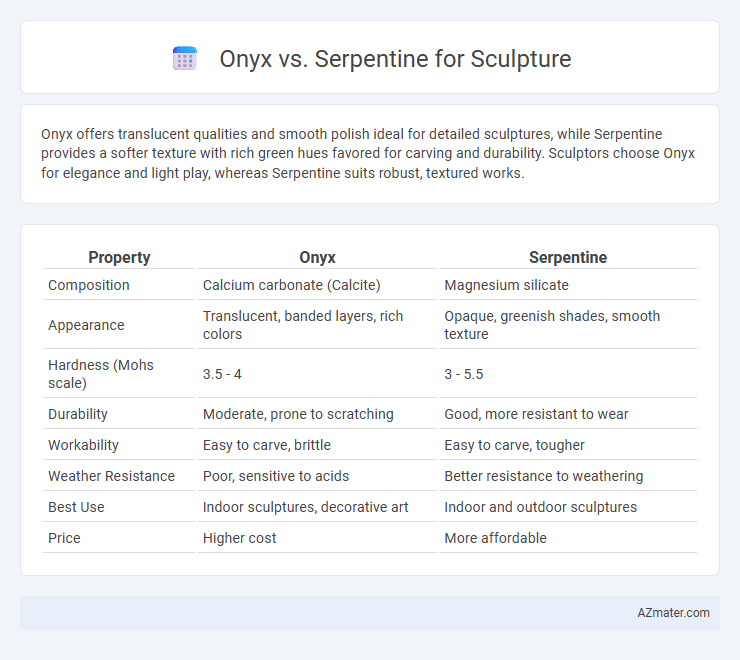Onyx offers translucent qualities and smooth polish ideal for detailed sculptures, while Serpentine provides a softer texture with rich green hues favored for carving and durability. Sculptors choose Onyx for elegance and light play, whereas Serpentine suits robust, textured works.
Table of Comparison
| Property | Onyx | Serpentine |
|---|---|---|
| Composition | Calcium carbonate (Calcite) | Magnesium silicate |
| Appearance | Translucent, banded layers, rich colors | Opaque, greenish shades, smooth texture |
| Hardness (Mohs scale) | 3.5 - 4 | 3 - 5.5 |
| Durability | Moderate, prone to scratching | Good, more resistant to wear |
| Workability | Easy to carve, brittle | Easy to carve, tougher |
| Weather Resistance | Poor, sensitive to acids | Better resistance to weathering |
| Best Use | Indoor sculptures, decorative art | Indoor and outdoor sculptures |
| Price | Higher cost | More affordable |
Introduction to Onyx and Serpentine in Sculpture
Onyx, a banded variety of chalcedony, is prized in sculpture for its striking layers of black and white, offering artists a distinctive visual depth and smooth polished finish. Serpentine, known for its rich green hues and softer texture, provides sculptors with easier carving properties and a unique, organic appearance often favored for ornamental pieces. Both stones showcase versatility in sculpture, but Onyx is valued for durability and sharp contrast, while Serpentine excels in malleability and natural color variation.
Geological Origins and Formation
Onyx is a banded variety of chalcedony formed through the layering of silica-rich solutions in volcanic lava, resulting in its distinct parallel bands of black and white. Serpentine originates from the alteration of ultramafic rocks, such as peridotite, through hydrothermal processes, producing a mineral rich in magnesium and iron with a typically greenish coloration. The geological formation of onyx involves sedimentary deposition in volcanic environments, whereas serpentine develops primarily in metamorphic contexts linked to tectonic plate boundaries.
Visual Characteristics and Color Variations
Onyx sculpture is prized for its strikingly smooth, translucent surface with rich black and white banding, creating a dramatic contrast that highlights intricate carving details. Serpentine features a softer, waxy luster with a wider palette ranging from pale greens, yellows, and browns to deep olive tones, often exhibiting subtle mottling or veining patterns. The visual depth of onyx emphasizes sharp clarity and high contrast, while serpentine's varied hues offer a warmer, earthier appearance suited for organic, flowing forms.
Workability and Artistic Techniques
Onyx offers a smooth, fine-grained texture that allows intricate detailing and polishing, making it ideal for delicate sculptures requiring precision and high finish. Serpentine's softer, slightly fibrous structure facilitates easier carving and shaping but may limit ultra-fine detail due to its variability and lower hardness. Artists favor onyx for sharp, refined lines, while serpentine supports more fluid, organic forms, allowing versatile use of chiseling, sanding, and polishing techniques.
Durability and Long-Term Preservation
Onyx offers superior durability for sculpture due to its hardness and resistance to weathering, making it ideal for both indoor and outdoor art installations. Serpentine, while visually appealing with its rich green hues, is softer and more prone to scratching and erosion over time, requiring careful maintenance. Long-term preservation favors onyx sculptures, as they withstand environmental stresses better, ensuring the artwork retains its structural integrity and aesthetic appeal for decades.
Historical Use in Sculptural Art
Onyx, prized by ancient civilizations such as the Egyptians and Romans, was favored for its fine grain and translucent quality, enabling detailed and polished sculptures symbolizing divinity and luxury. Serpentine, widely used by Native American cultures and in Mesoamerican art, offered a softer texture ideal for intricate carvings and was often associated with protection and spiritual significance. Both materials showcase a rich historical legacy in sculpture, with onyx highlighting refinement and serpentine emphasizing symbolic artistry.
Cost and Availability for Artists
Onyx, known for its translucent beauty and smooth texture, tends to be more expensive and less readily available than serpentine, which is abundant and cost-effective for artists. Serpentine's softer composition allows for easier carving, making it a popular choice for beginners and budget-conscious sculptors. The higher market demand and rarity of quality onyx slabs drive up costs, limiting its accessibility in comparison to the widespread availability of serpentine in art material suppliers.
Maintenance and Care Considerations
Onyx requires careful maintenance due to its softness and susceptibility to scratches and etching from acidic substances, demanding gentle cleaning with a mild soap solution and avoiding harsh chemicals. Serpentine offers greater durability and resistance to weathering, making it easier to clean with a soft cloth and neutral pH cleaners without frequent sealing. Both stones benefit from regular dusting and prompt removal of spills to preserve their natural luster and prevent surface damage.
Popular Sculpture Examples in Onyx vs Serpentine
Onyx sculptures, such as the intricate "Portrait of a Lady" by Italian Renaissance artists, demonstrate the stone's ability to achieve smooth, translucent finishes ideal for detailed facial expressions. In contrast, serpentine sculptures like the "Green Lady" by New Zealand Maori carvers highlight the stone's rich green tones and durability, favored for large, robust cultural figures. While onyx is prized for delicate, polished aesthetics, serpentine is valued for its vibrant color and structural strength in traditional and contemporary sculpture.
Choosing the Right Stone: Factors for Sculptors
Onyx offers a smooth, translucent surface ideal for detailed, polished sculptures, whereas serpentine provides a softer, more workable texture with rich green hues that enhance organic forms. Sculptors must consider the hardness, translucency, and color variations of each stone to match their project's aesthetic and technical requirements. Durability and ease of carving also influence the choice, with onyx favoring refined finishes and serpentine excelling in expressive, tactile designs.

Infographic: Onyx vs Serpentine for Sculpture
 azmater.com
azmater.com